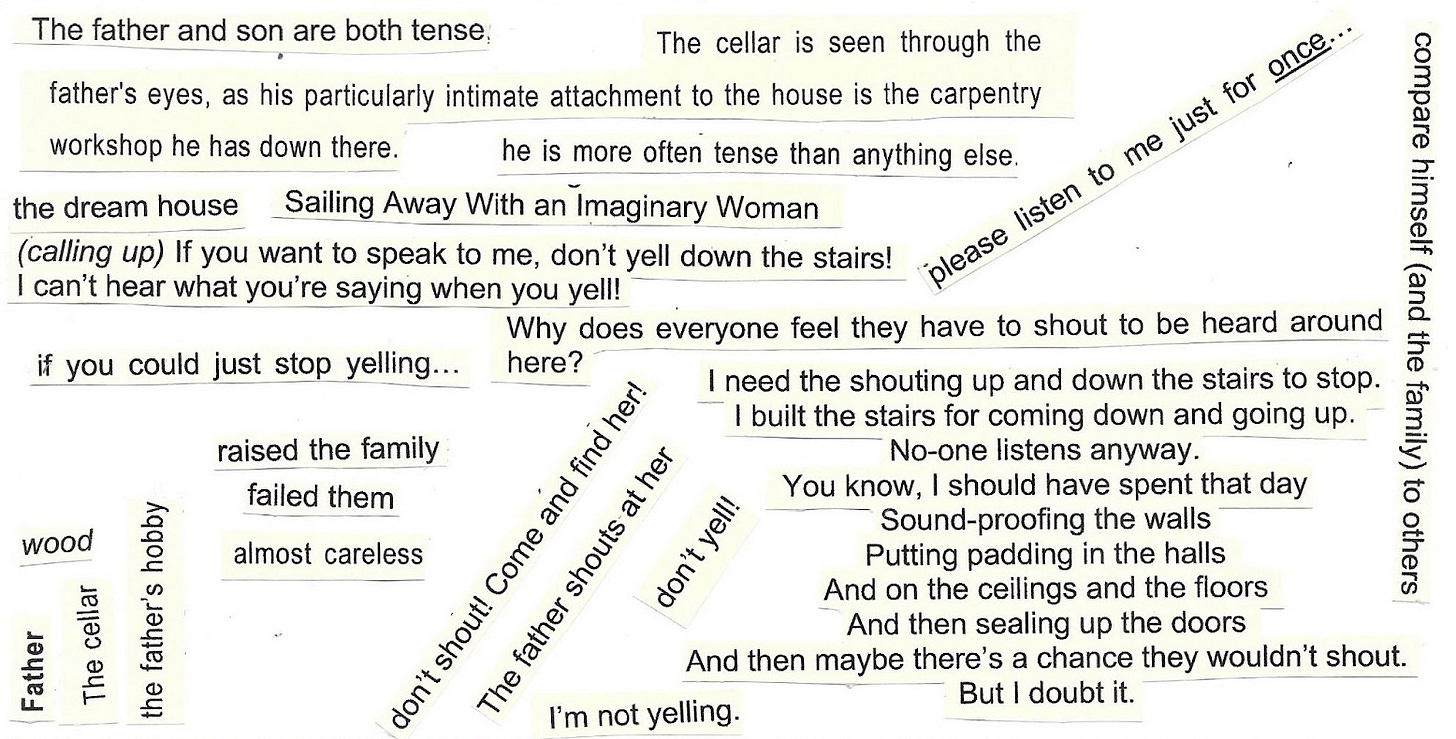A musical called four is the work of theoretical theatre* I’m currently sharing. Click here for the start of the story.
Here is the father.
(He doesn’t have to be the father. He doesn’t have to be a ‘he’. In that sense, imagine the character any way it works for you.)
Where there is containment with the mother, and constriction with the son, here with the father there is a cacophony, a caterwauling.
There is yelling, but there’s no listening. Shouting, but no hearing.
My family once lived in a tall, skinny house, and used the stairways for shouting. My father, whose study sat in the middle of it all, spent much time shouting that there should be less yelling, and yelling for less shouting.
(No-one listened, mind.)
Carpentry is loud. My father had a lathe on which he would turn things that started out as logs of lovely wood, and ended up as rounded lovely wood.
He wasn’t very good at anything other than the rounding, but the rounding was lovely. I would sit and watch him carefully and methodically turn rough into smooth, which pleased me in my (then unrealised) neurodivergence.
When I first worked on this show, I was telling a sailor friend about it, explaining the notion I had for the father, that all he does is varnish pieces of wood. He makes nothing other than a flat surface on a chunk of wood, then varnishes and sands it back, varnishes and sands it back, over and over again until the wood gleams.
Oh, said my friend, he’s a finisher. The woodwork on a boat is called the brightwork, and the varnishing of it is called finishing. Finishing is what makes the wood hardy. It’s what makes the wood ready. It’s what makes the brightwork shine.
My work is rarely finished. The industry and the world are in a tricky place when it comes to the arts, which are invaluable social tools available for free to literally everyone, and have therefore been commercially restricted for your own safety, or some shit.
Hence I’m a theoretical theatre maker. My brightwork rarely makes it to be fitted on a boat, but here I am, varnishing it. Finishing it so the essence of it shines, without worrying about making it into anything that might be deemed complete by the industry.
(And honestly, I am loving this so much more.)
Gaston Bachelard says, of the cellar:
“…it is first and foremost the dark entity of the house, the one that partakes of subterranean forces. When we dream there, we are in harmony with the irrationality of the depths.”
Of the four members of this family, I knew the father was the one lost in irrationality, down in the depths. Not because my father was that way: he was quite the opposite, a journalist who was always very present in what was happening in the world, and also in the family.
No, this is about sound, and about vibration. The mother is surrounded by things she sees, holds, smells, but the father is surrounded by noise and the vibrations of people trying to move house, he has withdrawn from it, down into the depths where he only has to harmonise with irrationality.
Perhaps he wants the time and space to imagine sailing away on a boat with perfectly finished brightwork. I’m not even sure about the imaginary woman, to be honest, unless she’s only there to evidence that it’s possible to be with another person and still have his own time and space. Or at least, to be surrounded by his own choice of sound, his own movements shaking up the dust.
This has always been a musical. I call everything I make a musical because it is all musical in some way.
The age-old assumption about musicals is that a character sings when they can no longer speak because their emotions are too strong.
I get it, but that’s not the only difference between speech and song. The two are different sound worlds. And silence is disregarded but equally available, powerful, versatile. I’m not talking about pauses, I’m talking about full silence, and full stillness.
I’m curious about the singing that might be in this show, and the signing, the shouting, the stepping, the speaking, the stomping, and the silence and stillness, and what might be used to compose, combine, choreograph, compare. I’m interested in the sounds and rhythms and vibrations of their house, and their history, and their hopes.
I’m wondering about the way we, the characters’ invisible friends, might physically move through the house towards them and away from them and, in that way, be in control of our own personal sound/vibration mix.
I’m imagining the moments when we might sing, sign, shout, step, speak, stomp, be silent and still with them, beneath them, above them, around them.
Sound, vibration… In theory, what do you hear/feel in the house so far, in the past present future? In theory, who are you gravitating towards or away from? In theory, where are you compelled to sing, sign, shout, step, speak, stomp, be silent and still here?
There is more to the father, but that will come later.
Click here to read the previous post: son
Click here to read the next post: daughter
*This may be theoretical theatre, but it’s still protected by Copyright © 2000-2025 by Jenifer Toksvig All Rights Reserved. Though I may be inspired by conversation and ideas, as long as you don’t infringe my copyright, anything you write in response to this belongs to you. Obviously. The Poetics of Space by Gaston Bachelard is translated into English by Maria Jolas, quoted here where referenced for the purposes of researching this work.





